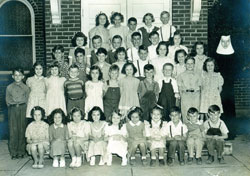New Albany Deanery parish overcame trials to pass on the faith

Members of the fourth and fifth grades of the former St. Michael School in Bradford pose in this photo from the mid-1940s. Benedictine sisters from Monastery Immaculate Conception in Ferdinand, Ind., in the Evansville Diocese, staffed the school at the time. The school was closed in 1971. (Submitted photo)
By Sean Gallagher
St. Michael Parish in Bradford is almost as old as the entire archdiocese.
Established in 1835, it was one of the first parishes founded by the Servant of God Bishop Simon Bruté after he was appointed the first bishop of Vincennes the previous year.
On Dec. 5 at 2 p.m., Archbishop Daniel M. Buechlein will be the principal celebrant during a Mass at the New Albany Deanery faith community to celebrate its 175th anniversary.
The liturgy will culminate a series of events to mark the anniversary, including a $2.5 million project to renovate an old parish hall and construct a new parish life center.
“The events that we’ve had have been well received and participated in,” said Father John Fink, the pastor of St. Michael Parish. “[The participation] is an expression of the whole faith community that has developed over the past 175 years.”
Founded primarily by German immigrants who moved to southern Indiana, St. Michael Parish still has many families among its 417 households that trace their history back to its earliest days.
“My great-great-great-great-grandparents on my mother’s side were married at St. Michael’s, and my family has attended there ever since,” said 21-year-old Audrey Harbeson, a member of the parish and a junior at Purdue University in West Lafayette, Ind.
Although the parish has deep roots for members like Harbeson, the faith that is passed on is alive and relevant to parishioners’ everyday lives in the 21st century.
“The friendships that I built at St. Michael [Parish] are built upon our shared Catholic faith, and this gives them a deeper foundation than others,” Harbeson said. “I know that I can turn to these friends for support when I need it the most, and that is very important to me.”
More than simply forming friendships, though, St. Michael Parish has helped young adults like Harbeson put their faith into action by helping others in need and building up the faith in other people.
Harbeson has participated in parish-sponsored mission trips to a South Dakota Indian reservation. And in college, she is building on the foundation of faith that she received at St. Michael by leading a faith renewal group and campus ministry choir at Purdue.
“I think [the parish] it is a great place for young adults,” Harbeson said. “There are many opportunities to get involved in ministry, whether it be music, teaching religious education or the new young adult mission trip program.
“I think that it also provides a great place to learn about our faith from those [people] more experienced in years. The members of St. Michael have always been very supportive of young people and our ideas.”
One of those “more experienced” parishioners is Charlie Fessel, 82. Like Harbeson, his family goes back to the earliest days of the parish. He even owns the farm on which the original parish church was built 175 years ago.
“It’s kind of been a hub,” Fessel said. “I got involved when we first got a Catholic school. I started going to school there in a one-room schoolhouse. Of course, we went to church every morning. I grew up being a part of it. I’ve been involved with it all my life.”
Although St. Michael has played an integral role in the life of faith of parishioners of all ages, there was a time not long before Fessel was born that the parish’s very existence was severely threatened.
In 1922, members of the Ku Klux Klan claimed responsibility for the burning of the parish’s church, which was the third one in its history at the time. Two more churches have succeeded it.
“They were pretty active around here,” Fessel said. “In fact, they burned one of my grandfather’s buildings. They had burned a cross in the road shortly before.”
John Jacobi, 40, the parish’s longtime director of religious education, recalls hearing stories from his grandparents about the responses of parishioners and the pastor to the destruction of their church.
First, they were determined to rebuild. The new church, however, would be made of brick. The previous church was a wood frame building.
“The thing I remember my grandfather telling me,” said Jacobi, “was that Father [John] Gorman, who was the pastor at the time, slept in the basement of the church with a shotgun as they were rebuilding in case someone came back.”
Such fears are thankfully long gone and, over the past generation, the parish has doubled in size, according to Jacobi.
Fessel says that is partly due to the area around Bradford becoming a bedroom community for people who commute to work in nearby Louisville.
“We might say Louisville is a suburb of Bradford now,” said Fessel with a laugh.
All joking aside, Fessel spoke with some pride about how the well-established families in the parish have welcomed newcomers.
“I think these new people are being accepted very well,” Fessel said. “At one time, it was the family, and outsiders could sometimes be pushed away. But I think we’re doing a very good job of inviting them and being a part of it.”
But if the desires of Stephanie Jacobi, John Jacobi’s 16-year-old daughter, are any indication, the future of St. Michael will always involve families that go back in its 175-year-history.
“I really hope to stay there,” Stephanie said. “Even if I don’t live right here in Bradford, I’d love to still come here and bring my kids here.
“I’ve always dreamed of that because I’ve loved growing up in it. So I really want my kids to experience that, too.” †
